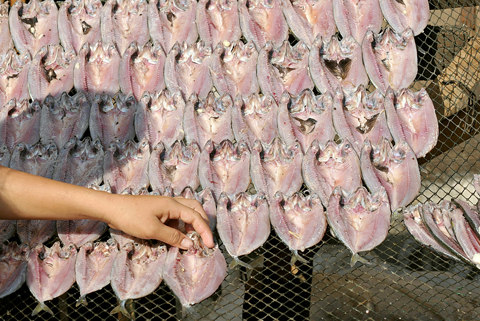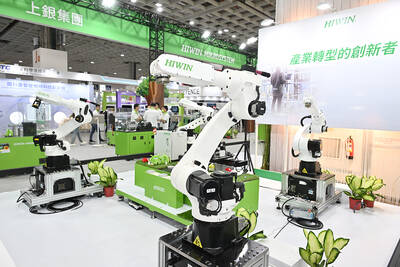Seventeen million Asians have fallen into extreme poverty because of the global financial crisis, the Asian Development Bank (ADB) and the UN said yesterday.
And another 4 million could this year slip into the same situation because of the effects of the slump, officials from the two organizations said at the launch of a joint report on poverty alleviation in Manila.
This is on top of the 900 million people in Asia who are already living in extreme poverty, defined as living on less than US$1.25 a day.

PHOTO: AFP
Asia had shown great progress in bringing people out of poverty in recent years, ADB vice-president Ursula Schaefer-Preuss told reporters.
“But gains are being reversed due to the economic crisis,” she said.
UN Under-Secretary General Noeleen Heyzer said that people in the export and tourism sectors in Asia had lost and were still losing their jobs because of the crisis, which swept across the globe in late 2008.
Less foreign investment, aid and remittances from foreign workers were further hurting Asia’s poor, Heyzer said.
The report said more women, who form the majority of Asia’s low-skilled and temporary workforce, than men had been forced back into extreme poverty because of the crisis.
UN Assistant Secretary-General Ajay Chhibber said the Asia-Pacific was doing quite well in areas such as infrastructure in achieving the UN’s Millennium Development Goals that are aimed at bringing people out of poverty.
“But it lags woefully behind in social issues,” he said.
Even Latin America and Eastern Europe had better “social protections” than Asia such as pensions and unemployment insurance, Chhibber said.
Only 2 percent to 3 percent of GDP in Asia goes to such social protections, he said, adding that this figure should ideally be 4 percent to 6 percent.
This meant large numbers of Asians could fall back into poverty during the crisis or even during natural disasters, he said.

Taiwan Semiconductor Manufacturing Co (TSMC, 台積電), the world’s biggest contract chipmaker, booked its first-ever profit from its Arizona subsidiary in the first half of this year, four years after operations began, a company financial statement showed. Wholly owned by TSMC, the Arizona unit contributed NT$4.52 billion (US$150.1 million) in net profit, compared with a loss of NT$4.34 billion a year earlier, the statement showed. The company attributed the turnaround to strong market demand and high factory utilization. The Arizona unit counts Apple Inc, Nvidia Corp and Advanced Micro Devices Inc among its major customers. The firm’s first fab in Arizona began high-volume production

VOTE OF CONFIDENCE: The Japanese company is adding Intel to an investment portfolio that includes artificial intelligence linchpins Nvidia Corp and TSMC Softbank Group Corp agreed to buy US$2 billion of Intel Corp stock, a surprise deal to shore up a struggling US name while boosting its own chip ambitions. The Japanese company, which is adding Intel to an investment portfolio that includes artificial intelligence (AI) linchpins Nvidia Corp and Taiwan Semiconductor Manufacturing Co (TSMC, 台積電), is to pay US$23 a share — a small discount to Intel’s last close. Shares of the US chipmaker, which would issue new stock to Softbank, surged more than 5 percent in after-hours trading. Softbank’s stock fell as much as 5.4 percent on Tuesday in Tokyo, its

COLLABORATION: Softbank would supply manufacturing gear to the factory, and a joint venture would make AI data center equipment, Young Liu said Hon Hai Precision Industry Co (鴻海精密) would operate a US factory owned by Softbank Group Corp, setting up what is in the running to be the first manufacturing site in the Japanese company’s US$500 billion Stargate venture with OpenAI and Oracle Corp. Softbank is acquiring Hon Hai’s electric-vehicle plant in Ohio, but the Taiwanese company would continue to run the complex after turning it into an artificial intelligence (AI) server production plant, Hon Hai chairman Young Liu (劉揚偉) said yesterday. Softbank would supply manufacturing gear to the factory, and a joint venture between the two companies would make AI data

The Taiwan Automation Intelligence and Robot Show, which is to be held from Wednesday to Saturday at the Taipei Nangang Exhibition Center, would showcase the latest in artificial intelligence (AI)-driven robotics and automation technologies, the organizer said yesterday. The event would highlight applications in smart manufacturing, as well as information and communications technology, the Taiwan Automation Intelligence and Robotics Association said. More than 1,000 companies are to display innovations in semiconductors, electromechanics, industrial automation and intelligent manufacturing, it said in a news release. Visitors can explore automated guided vehicles, 3D machine vision systems and AI-powered applications at the show, along